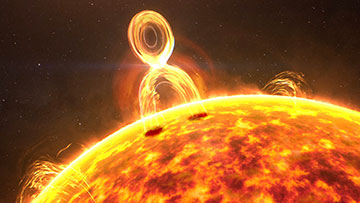
An artist’s impression showing magnetic reconnection in the form of a solar flare on the surface of the sun. This process involves the collision of anti-parallel fields and hurls charged particles into space. [Image: NASA Conceptual Image Lab]
Scientists in Japan have probed the physics of solar flares, making detailed measurements of a process known as magnetic reconnection. They did so not using a detector in space but with two sets of laser beams in a laboratory—one set to create a pair of oppositely magnetized plasmas and the other to study how the two magnetic fields combine and discharge energy in the form of ion jets (Phys. Rev. E, doi: 10.1103/PhysRevE.106.055207).
Mystery of reconnection
Magnetic reconnection occurs when two anti-parallel magnetic fields collide. Initially, the fields occupy distinct volumes of plasma that nevertheless almost touch one another, being separated by an essentially two-dimensional region of electrical current known as a current sheet. Because that region has a high energy density, it is unstable. So before long, the two sets of field lines split up, and the fragmented field lines combine with their corresponding opposites to yield field lines that propagate at right angles to the original ones. In the process, pent-up magnetic energy is converted into thermal and kinetic energy.
This phenomenon is thought to be responsible for solar flares, with the liberated energy accelerating electrons and other charged particles to enormous speeds. It also takes place in the Earth’s magnetosphere when a reconnection between the terrestrial and solar magnetic fields can inject charged particles into the atmosphere and give rise to aurorae. Moreover, it is also a feature of fusion reactors, causing instabilities that hamper the generation of fusion energy.
Reconnection has been extensively studied using satellites and ground-based experiments. But it is a complex process since it involves both the microscopic dissipation of magnetic energy at the level of individual electrons and the macroscopic movement of magnetic fields via bulk plasma. In particular, researchers are still unable to explain the speed of reconnection and exactly how magnetic energy is converted into particles’ kinetic energy.
Firing lasers
Taichi Morita of Kyushu University and colleagues set out to gain a deeper insight into the process via optical diagnostics. They did so using the Gekko-XII laser system at Osaka University, firing two sets of pulses—each lasting just 1.3 ns but packing around 700 J of energy—at thin pieces of carbon foil. The pulses turned the carbon into a plasma with its own magnetic field, which spontaneously generated thanks to the variation in density and temperature gradients created around the points of impact.
To follow the dynamics of these fields, the researchers exploited two different types of measurement. The more straightforward of these was to detect the radiation naturally given off by thermal electrons in the plasma. This “self-emission” revealed that the laser pulses generate their respective plasmas with anti-parallel magnetic fields and that those plasmas (initially 2 mm apart) expand outwards so that by around 7 ns after impact, they begin to merge with one another.
The second diagnostic confirmed this picture but provided greater detail about the mechanics of reconnection. This involved firing an additional, low-energy laser beam at the mid-point of the two expanding plasmas and a spectrometer to measure how the intensity and wavelength of the Thomson scattered light varied in space and time.
Making these measurements at right angles to the two sets of field lines, Morita and co-workers found that at a given distance from the midpoint, there were two peaks in the scattering spectrum. Up until around 7 ns after the impact, one of these peaks was higher than the other, but by about the 9-ns mark, the two peaks become equally pronounced. They interpret the initial asymmetry as being due to the formation of an electric current—the current sheet—and its subsequent reduction as the disappearance of that current.
Future outlook
By instead measuring the spectrum parallel to the field lines, the researchers found that the blue- and red-shifted peaks had different widths. This, they say, implies an asymmetry in the distribution of velocities of ions within the plasmas, or in other words, the production of two ion jets traveling outwards in opposite directions. The upshot, they conclude, is magnetic reconnection—the conversion of magnetic energy from the incoming plasmas to the kinetic energy of the ions.
The researchers add that a still better understanding of the reconnection process could be achieved by using a magnetic field measurement such as proton radiography to more precisely gauge the reconnection rate—a measure of how quickly reconnection occurs. Relying for the moment on measurements of plasma velocity and electric current, they estimate the rate to be about 0.1.
More broadly, the researchers reckon that their laser-based measurements could improve knowledge of other astrophysical phenomena, such as shockwaves, cosmic-ray acceleration and magnetic turbulence. “Many of these phenomena can damage and disrupt electrical devices and the human body,” says Morita, quoted in a press release from Kyushu University. “So, if we ever want to be a space-faring race, we must work to understand these common cosmic events.”
